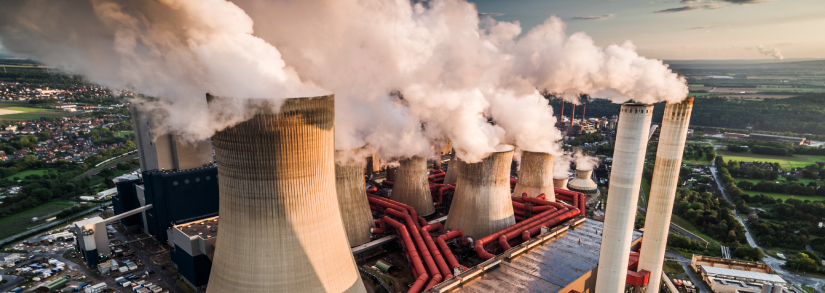
- Emissions-intensity metrics can provide a common benchmark to compare the relative contributions of different holdings to a portfolio’s carbon footprint.
- Adding a time-series element to this analysis can distinguish between actual reductions versus changes related to other fundamental factors such as revenue and enterprise value including cash.
- COVID-19-related reductions in emissions intensity for industries like airlines may be more likely to reverse compared to those for industries that have demonstrated a sustained reduction over time, such as utilities.
There is growing awareness among investors on the part they have to play on the road to net-zero emissions. This has gained traction in recent years on the back of legislation and other regulatory proposals around the reporting of emissions at portfolio level.
Visualizing carbon intensities at an industry level can be a useful tool to quickly diagnose which elements of a portfolio are responsible for driving its carbon footprint. This can help investors identify where their targets for active engagement could be, as well as establish an industry-specific benchmark to screen for individual leaders and laggards within that industry.
Carbon intensity: A multipurpose metric
Carbon intensities can also help evaluate emissions trends across industries of different sizes and business activities, as metrics such as direct carbon emissions in metric tons of CO2 equivalent per USD 1 million of enterprise value including cash (tCO2e/USD million EVIC) enable an intuitive, apples-to-apples comparison.1 Carbon-emissions intensity can therefore be seen as a crucial benchmark for both investors looking to build investment products aligned with net-zero-emissions pathways and investors seeking to demonstrate interim progress toward portfolio alignment with climate initiatives like the Glasgow Financial Alliance for Net Zero (GFANZ).
The 20 most carbon-intensive industries
Industry averages of MSCI ACWI Investable Market Index (IMI) constituents as of June 28, 2022. Due to availability of company disclosures, carbon intensities for fiscal year 2020 are visualized. Source: MSCI ESG Research
Time-series can enhance carbon-intensity analysis
Comparing industry emissions intensities at a point in time offers a relative, albeit static, comparison of carbon footprints. In fiscal year 2020, construction materials showed the highest carbon intensity among the industry groups of the MSCI ACWI Investable Market Index (IMI). However, simply drawing conclusions based on this ranking alone may lead investors to miss the forest for the trees.
Adding a perspective of change over time can help illustrate sector decarbonization trends, which may offer more insights than a snapshot at a given point in time. This approach starts with identifying a suitable time period. By choosing 2016 to 2020, we can capture both the starting point of where industries were when the Paris Agreement was signed and how they responded to the initial wave of COVID-19-related financial impacts. For example, within this five-year period, the airlines industry showed a pronounced drop in emissions intensity due to the initial wave of the pandemic in 2020, while the utilities industry saw a much steadier rate of decrease every year.
Change in carbon intensities by industry
How to use this chart: Click on an industry in the scatter plot to see its five-year trends in the two charts above. Hover over a datapoint in the scatter plot to see more details about how its enterprise value including cash and emissions changed from 2016 to 2020. Industry averages of MSCI ACWI Investable Market Index (IMI) constituents as of June 28, 2022. Source: MSCI ESG Research
Unraveling emission-intensity changes: Fundamental factors at play
In addition to examining trends from a time-series perspective, investors can take their analysis one step further. The knee-jerk reaction to attribute an industry’s decreasing carbon intensity to better emissions management by its constituents may miss broader factors that were responsible for increasing the EVIC of these companies during the same period. Therefore, an industry could still be facing similar exposure to carbon-related risks masked under a decreasing emissions intensity over time. Likewise, an increase in carbon-emissions intensity could simply reflect contractions in EVIC rather than worsening performance on managing emissions. Examining the interaction of all variables driving carbon-emissions-intensity metrics may reveal more nuanced decarbonization trends at an industry-specific level.
Over this five-year period (2016-2020), even though industries such as air freight and logistics and commodity chemicals showed more than a 20% decrease in their carbon intensity, their absolute emissions increased (by 27% and 32%, respectively). The lower carbon intensity is a result of a higher rate of increase in EVIC (59% and 88%, respectively). At the same time, the carbon-emissions intensity of oil and gas exploration and production increased by 43%, driven by a much larger decrease in EVIC (-28%) compared to its increase in carbon emissions (2%).
Improved transparency, but analysis will be key
As more data from fiscal years 2021 and 2022 becomes available, we will get a better picture of how the pandemic has affected progress on decarbonization across industries. While impending disclosure requirements and initiatives such as GFANZ’s Net-Zero Data Public Utility may bring more transparency around companies’ emissions data over the next few years, rigorous analysis of metrics like carbon-emissions intensity could help investors identify emerging decarbonization opportunities and lingering exposure to emissions-related risks.
1 Direct emissions cover a company's operations, commonly referred to by the Greenhouse Gas Protocol as Scope 1 and 2 emissions.
Further Reading
Are Emissions Rising or Falling in Equity Indexes?
Keeping Energy Exposure While Lowering Emissions
Net-Zero Alignment for Multi-Asset-Class Portfolios
Portfolio Intelligence Through a Carbon-Efficiency Factor
